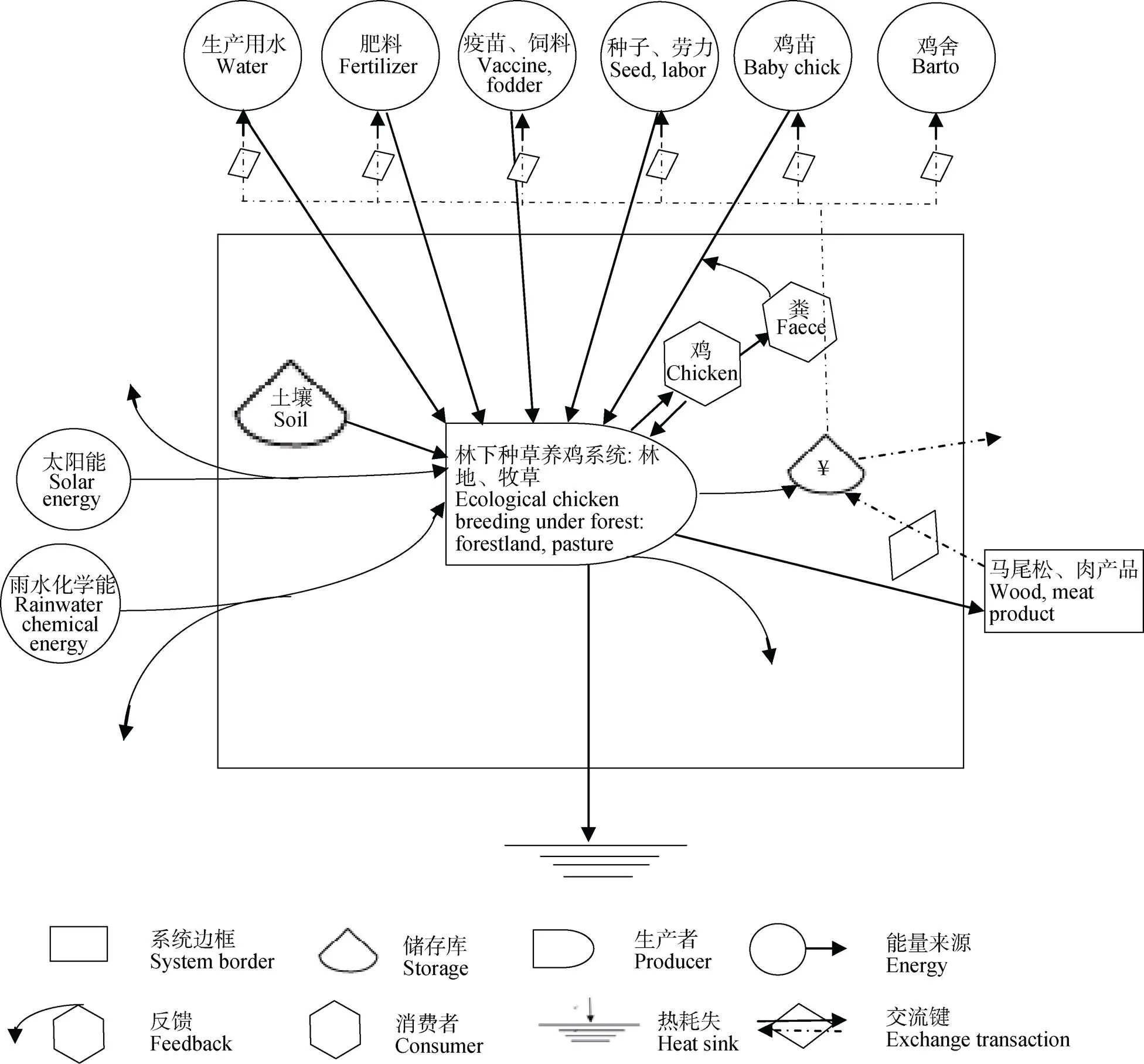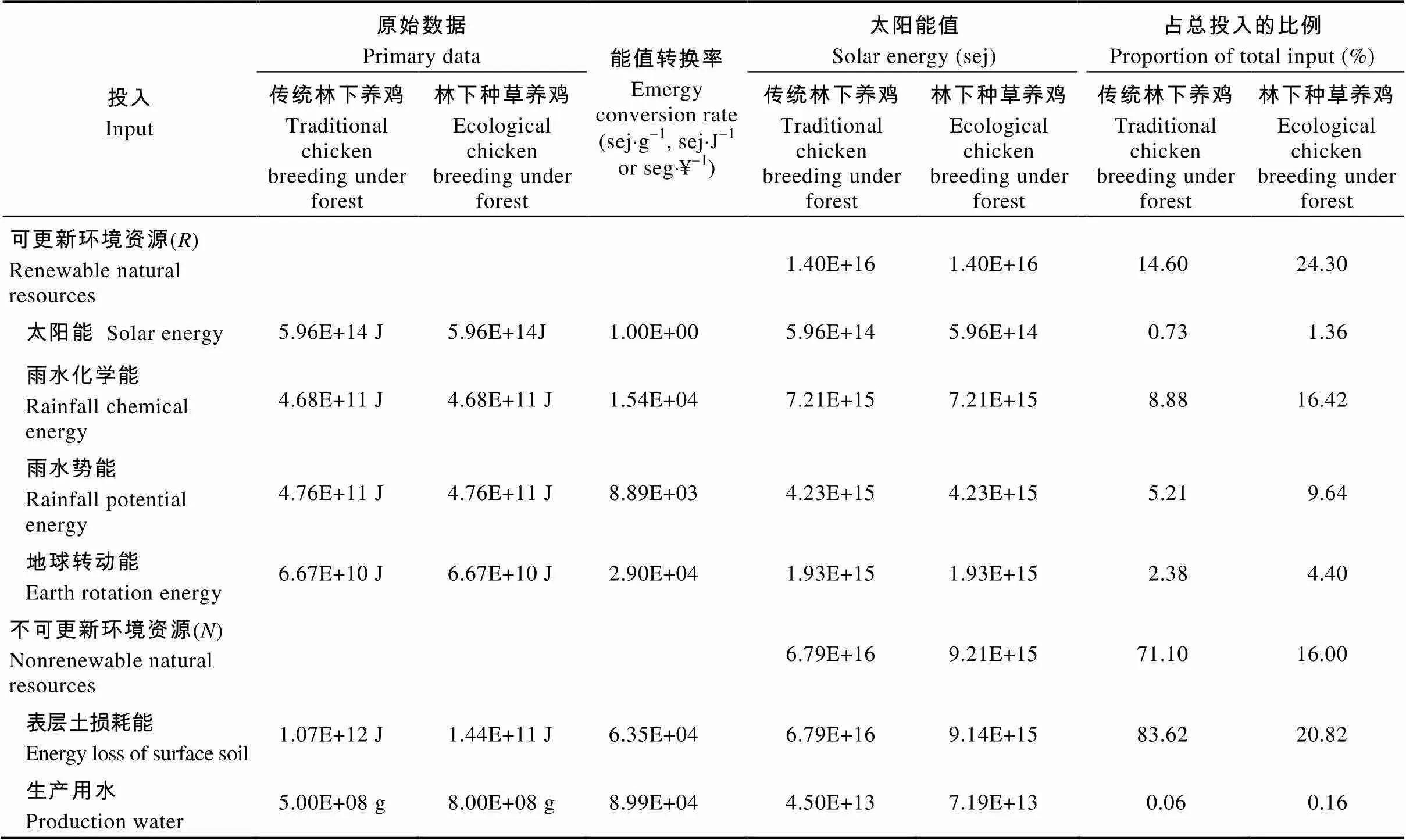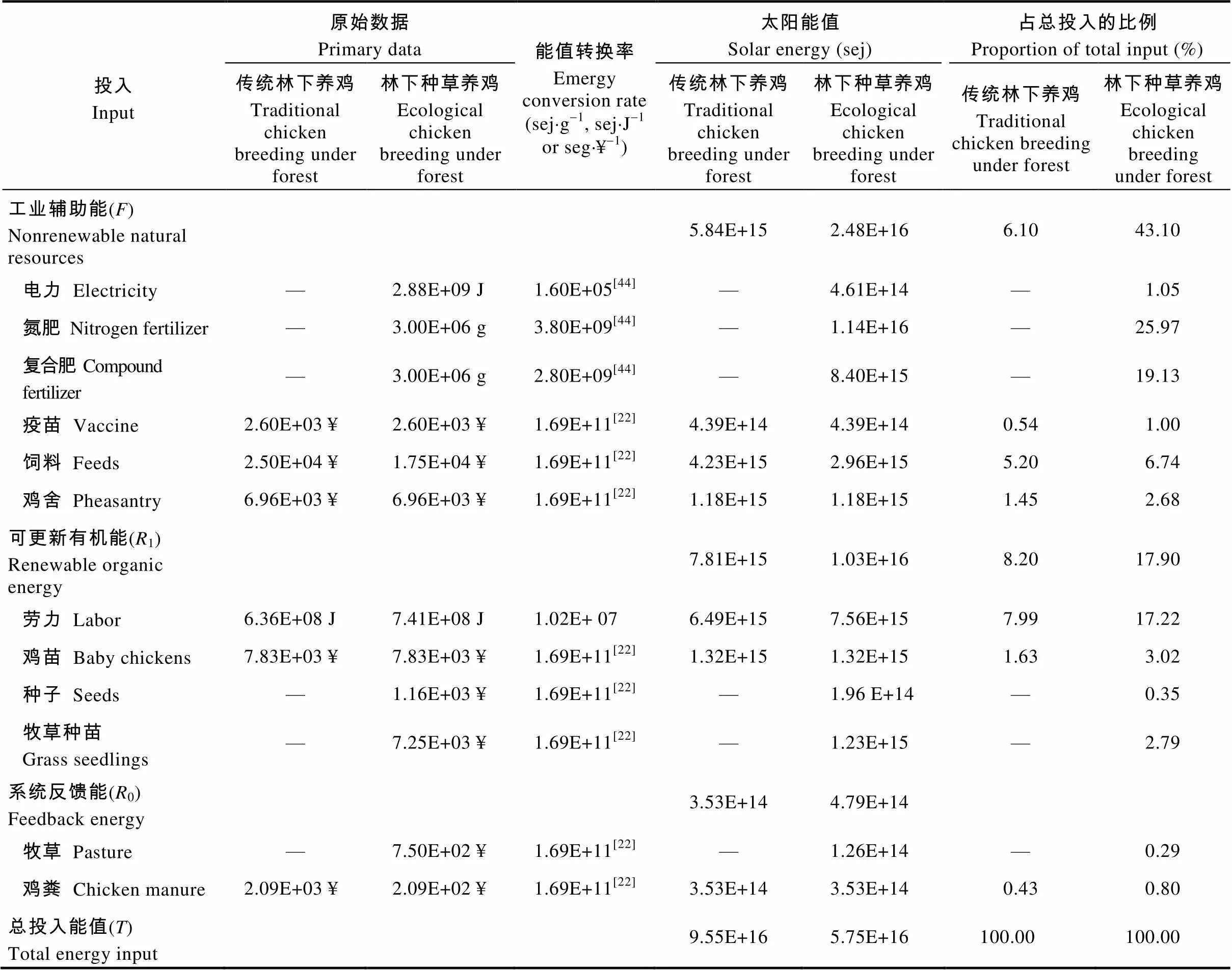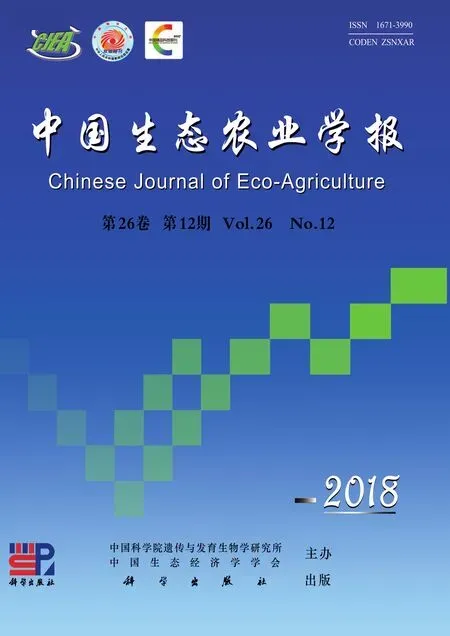基于能值分析的马尾松低效林林下种草养鸡耦合模式评价*
2018-11-29高承芳张晓佩罗旭辉李文杨翁伯琦
高承芳, 黄 颖, 张晓佩, 罗旭辉, 陈 恩, 李文杨, 翁伯琦
基于能值分析的马尾松低效林林下种草养鸡耦合模式评价*
高承芳1, 黄 颖2, 张晓佩1, 罗旭辉3**, 陈 恩3, 李文杨1, 翁伯琦3
(1. 福建省农业科学院畜牧兽医研究所 福州 350013; 2. 福建省农业科学院农业经济与科技信息研究所 福州 350003; 3. 福建省农业科学院农业生态研究所/福建省红壤山地农业生态过程重点实验室 350013 福州)
马尾松低效林是红壤侵蚀区典型植被类型。林下种草养鸡则是林下种草与林下养鸡的耦合新模式, 既能解决马尾松林下水土流失问题, 又能提高经济效益, 实现生态种养循环, 驱动水土流失治理。为科学评价马尾松低效林林下种草养鸡模式的生态经济效益, 本文应用能值分析法, 测评福建省长汀县三洲镇垌坝村传统林下养鸡(对照)、林下种草养鸡两种模式的能值自给率、能值投资率、净能值产出率、环境负载率、可持续发展指数和能值反馈率。结果表明, 传统林下养鸡模式的能值自给率、能值投资率、净能值产出率、环境负载率、可持续发展指数和能值反馈率分别为0.860、0.166、2.125、3.380、0.629和0.026, 林下种草养鸡模式上述指标值分别为0.400、1.510、0.870、1.370、0.635和0.290。林下种草养鸡模式的能值投资率、可持续发展指数比对照提高1.344和0.006个单位, 显示更强的经济活力; 能值自给率、环境负载率比对照下降0.460、2.010个单位, 显示更低的环境负载。林下种草养鸡模式的净能值产出率低于对照1.255个单位, 而能值反馈率高出对照0.264个单位。总体而言, 林下种草养鸡耦合模式经济活力更强, 环境负载更低, 符合脆弱区林下经济发展趋势。侵蚀区土壤结构性差, 限制了从系统外导入的化肥在循环系统中功能的发挥, 导致系统净能值产出率、能值反馈率较低, 这为该模式的优化指明了方向。
红壤侵蚀区; 马尾松低效林; 水土流失; 林下经济; 种草养鸡; 能值分析
福建省长汀县是我国南方花岗岩红壤水土流失最严重和最具代表性的地区之一。经过多年治理, 植被覆盖度达0.7以上, 基本完成了植被覆盖[1-3], 但是林下水土流失依然严重。研究表明, 长汀县林下水土流失面积达311.66 km2, 13.35%为中度侵蚀[4-5], 是下一步治理的重点任务之一, 尤其是马尾松()低效林林下水土流失严重。学者们普遍认为, 林下覆盖度低是导致林下水土流失的直接原因[6-9]。在林下植被重建过程中发现侵蚀坡面土壤养分低、土壤结构差是导致林下植被和马尾松生长困难, 出现“老头松”现象的根本原因[10-11]。研究结果显示, 在人为增施有机肥、封禁等人工干预条件下, 马尾松生长得到明显改善[12], 因此, 土壤有机质重建是林下植被恢复和马尾松林分改良的重要物质基础。在实践过程中, 由于侵蚀区马尾松林基本无经济收入, 如何实施有机肥上山工程是当前林下水土流失治理面临的直接问题。通过构建林下种草与生态养鸡的耦合模式, 应用林下生态养鸡获得的经济效益来驱动有机肥上山, 是进一步推动马尾松低效林林下水土流失治理的重要途径[13-16]。林下种草养鸡是一种生态种养模式, 通过划区轮牧, 林下种草, 适度养殖, 鸡粪还田, 建立稳定林下植被, 实现林下水土流失治理[17-18]。
生态经济效益的科学评价是林下种草养鸡耦合模式构建的重要内容。能值分析是定量分析系统结构、功能与生态经济效益的研究方法之一, 已广泛应用于生态脆弱区生态系统的可持续性评价[19-23]。近些年来能值评价相关研究在国内外发展迅速, 在农业研究领域已经得到一定程度的应用。由于能值评价方法对于环境资源价值的考虑, 使该方法特别适用于分析同时涉及到自然环境和人类经济活动的生态经济系统[24-25]。王小龙等[26]采用能值分析方法对无公害设施蔬菜生产系统两种蔬菜栽培模式进行系统效率和可持续性评价, 并与一般蔬菜生产模式进行对比。杨滨娟等[27]采用能值分析理论评价水旱轮作条件下稻田生态系统的可持续性。孙卫民等[28]基于能值分析方法对江西省水稻()(早稻和晚稻)、棉花(spp.)、油菜()种植系统的经济效益、生态经济综合效益进行分析和评价。韩玉等[29]表明有针对性地构建适于不同层面的循环农业评价体系, 才能为制定科学合理循环农业发展规划提供参考。由此可知, 能值分析方法已广泛应用于农业、工业领域, 并且应用于“猪-沼-果”、“四位一体”、“猪-沼-菜”、“稻-鸭”及其他沼气循环农业等模式的评估[30-37], 同时还出现了一些由能值分析与生命周期评价、生态足迹等方法结合而成的新方法[38-43], 它们极大地丰富了循环农业系统评价理论的内涵。
总体来看, 尽管能值评价作为众多生态经济系统分析方法之一, 其出现时间较晚, 但无论在国内或国外学术界, 其应用都相当广泛。因此, 本研究运用Odum[44]和蓝盛芳等[45]的能值分析方法, 对典型红壤区林下生态养殖和林下传统养殖模式进行能值分析, 旨在分析两种模式对生态经济效益与生态环境可持续发展指数的影响, 为今后林下养殖模式提供借鉴。
1 研究地区概况与研究方法
1.1 研究地区概况
研究的马尾松林地位于福建省长汀县三洲镇垌坝村(24°47′~25°35′N, 116°40′~117°20′E), 海拔250~450 m, 属亚热带季风气候, 年均温度18.8~19.2 ℃, 年均降雨量1 500~1 700 mm, 无霜期282 d左右。马尾松林龄3年, 林分以马尾松为主, 面积为6.67 hm2, 林分郁蔽度35%~70%, 林龄12年, 陡坡地, 平均坡度37°, 土壤为花岗岩红壤。林地土壤贫瘠, 0~20 cm土层pH 5.0~5.3, 土壤容重1.33~1.38 g×cm-3, 有机质含量为0.32 g×kg-1, 砂砾含量77%~80%。
在试验地设置传统林下养鸡试验区和林下种草养鸡试验区, 并开展了林分质量、土壤侵蚀量、物种多样性等调查, 调查方法和结果详见文献[46], 林下生境基础条件与土壤条件基本相同。林下种草养鸡模式的伴生树种有: 杨梅()、乌饭树()、茶树()、光叶石楠()、岗松()、秤星树(), 林下灌草主要有: 芒萁()、鹧鸪草()、野古草()、五节芒()和榧树()。传统林下养鸡模式伴生树种与灌草有: 杨梅、茶树、野古草、五节芒。
1.2 研究方法
1.2.1 系统界定
传统林下养鸡模式: 在传统林下养殖区内(选择有代表性的马尾松林地), 每年散养河田鸡3批, 每批6 000羽, 2014年共饲养18 000羽, 鸡苗60日龄, 存活率95.3%, 饲养周期100 d左右, 鸡采食饲料、虫子、砂砾, 建设简易鸡舍。2014年测得土壤侵蚀量(用侵蚀针法测定)890 t×km-2[46]。
林下种草养鸡模式: 在上述面积为6.67 hm2的马尾松林地内,林下种植宽叶雀稗()、百喜草()、印度豇豆()、钝叶决明(var.)、杂交狼尾草(), 几种牧草按宽叶雀稗50%、其他牧草各10%的比例混合种植, 于2013年4月份播种, 2014年各牧草形成草场后进行观测分析。其中杂交狼尾草草篱种植, 共分10个大区, 每个大区面积约0.67 hm2; 放牧河田鸡密度为900羽×hm-2, 每个大区设4个小区, 实施轮牧, 周期为100 d, 饲养周期100 d左右, 鸡采食饲料、牧草、虫子、砂砾, 配套建设高脚鸡舍、水管、电力设施。2014年共饲养18 000羽, 存活率95.9%。2014年测得土壤侵蚀量(用侵蚀针法测定)30 t×km-2[46]。
1.2.2 能值分析及数据处理
本研究的基础数据是根据系统内2014年度的投入和产出, 以及记录当地气象部门的气象数据计算得出, 并绘制传统林下养鸡和林下种草养鸡模式的能值流程图。将调查的原始数据转化成以J、g、¥为单位的能量或物质数据, 将不同度量单位转换为统一的能值单位(sej), 编制能值分析表。并列出系统的主要能量来源和输出项目, 以及各能量或物质的太阳转化率, 太阳能值转化率主要参考蓝盛芳等[45]和Odum[44]的方法[47-48], 其中能值货币比参考方芸芸等[22]的研究结果(1.69E+11 sej×¥-1)。
能值理论的相关计算公式如下:
能值自给率(ESR)=环境的无偿能值(+)/能值
总投入() (1)
能值投资率(EIR)=经济的反馈能值(+1)/环境的
无偿能值(+) (2)
净能值产出率(EYR)=系统产出能值()/经济的
反馈能值(+1) (3)
环境负载率(ELR)=系统不可更新能值总量(+)/可
更新能值总量(+1+0) (4)
可持续发展指数(ESI)=净能值产出率(EYR)/环境
负载率(ELR) (5)
能值反馈率(FYE)=系统产出能值反馈量(0)/经济的
反馈能值(+1) (6)
2 结果与分析
2.1 能值流分析
与传统林下养鸡模式相比, 林下种草养鸡系统内部有林地与牧草, 外部投入增加了生产用水、肥料、草种、鸡舍建设等4个部分(图1, 图2)。林地与牧草作为整个系统的生产者, 其中, 用于交换货币流的有生产用水、肥料、疫苗、饲料、种子、鸡苗、鸡舍等部分, 反馈能有粪便与牧草2部分。系统产出主要有肉产品与马尾松。林下种草养鸡系统一是提供饲草, 供鸡采食, 节约饲料成本(根据鸡每天的采食量, 计算出林下种草可替代30%饲料); 二是覆盖地表, 调节地面温度, 为马尾松生长、河田鸡休憩提供良好条件(尤其是夏季高温, 侵蚀地土壤砂砾比例大, 地表温度高); 三是林下种植牧草, 减少土壤侵蚀和消纳排泄物, 大大减少土壤系统的能量耗散(图1)。

图1 林下种草养鸡耦合模式能量流动
2.2 能值投入分析
传统林下养鸡与林下种草养鸡模式的能值投入分析结果表明(表1), 两种模式总投入能值分别为9.55E+16 sej、5.75E+16 sej, 后者比前者下降39.8%。就不同类型能值投入比例而言, 传统林下养鸡模式可更新环境资源、不可更新环境资源、工业辅助能、可更新有机能投入分别占总投入能值的14.6%、71.1%、6.1%、8.2%。不可更新环境资源投入占主要比例, 尤其是表层土损耗能巨大, 损失高达6.79E+16 sej, 占总投入能值71.1%。林下种草养鸡模式可更新环境资源、不可更新环境资源、工业辅助能、可更新有机能投入分别占总投入能值的24.3%、16.0%、43.1%、17.9%。与传统模式相比, 林下种草养鸡模式的不可更新环境资源投入明显下降, 降幅达5.87 E+16 sej, 表层土流失控制发挥主要作用; 工业辅助能明显提高, 增幅达1.89 E+16 sej, 化肥投入贡献了大部分能值; 可更新有机能小幅提升, 增幅达2.49 E+15 sej, 主要是劳动力、牧草种苗等方面的投入增加。就系统反馈能而言, 传统林下养鸡模式、林下种草养鸡模式分别为3.53E+14 sej、4.79E+14 sej, 无明显变化, 虽然林下种草养鸡模式产生了部分可供河田鸡采食的牧草, 但鸡粪是反馈能值的主要贡献者。
2.3 能值产出分析
传统林下养鸡与林下种草养鸡2种模式的能值产出分析结果表明(表2), 传统林下养鸡、林下种草养鸡模式的能值产出分别为2.89E+16 sej、3.07E+16 sej, 后者较前者提高6.2%。在两种模式中, 肉产品与马尾松仍是主要的能值产出组分, 林下种草养鸡模式的优势在于马尾松长势明显加快, 能值产出是传统林下养鸡模式的1.71倍[传统林下养鸡、林下种草养鸡模式马尾松蓄积量分别为21.24 m3×hm-2(2014年数据)和36.35 m3×hm-2(2017年数据)], 也是总产出能值增加的重要原因。

图2 林下养殖河田鸡(传统养殖)模式的能值流动图
表1 马尾松林下2种养鸡模式的能值投入
Table 1 Energy inputs of 2 chicken breeding modes underforest

投入Input原始数据Primary data能值转换率Emergy conversion rate (sej×g-1, sej×J-1 or seg×¥-1)太阳能值Solar energy (sej)Seed labor force 占总投入的比例Proportion of total input (%) 传统林下养鸡Traditional chicken breeding under forest林下种草养鸡Ecologicalchicken breeding under forest传统林下养鸡Traditionalchicken breeding under forest林下种草养鸡Ecologicalchicken breeding under forest传统林下养鸡Traditionalchicken breeding under forest林下种草养鸡Ecologicalchicken breeding under forest 可更新环境资源(R)Renewable natural resources1.40E+161.40E+1614.6024.30 太阳能Solar energy5.96E+14 J5.96E+14J1.00E+005.96E+145.96E+140.731.36 雨水化学能Rainfall chemical energy4.68E+11 J4.68E+11 J1.54E+047.21E+157.21E+158.8816.42 雨水势能Rainfall potential energy4.76E+11 J4.76E+11 J8.89E+034.23E+154.23E+155.219.64 地球转动能Earth rotation energy6.67E+10 J6.67E+10 J2.90E+041.93E+151.93E+152.384.40 不可更新环境资源(N) Nonrenewable natural resources6.79E+169.21E+1571.1016.00 表层土损耗能Energy loss of surface soil1.07E+12 J1.44E+11 J6.35E+046.79E+169.14E+1583.6220.82 生产用水Production water5.00E+08 g8.00E+08 g8.99E+044.50E+137.19E+130.060.16
表1 续

投入Input原始数据Primary data能值转换率Emergy conversion rate (sej×g-1, sej×J-1 or seg×¥-1)太阳能值Solar energy (sej)Seed labor force 占总投入的比例Proportion of total input (%) 传统林下养鸡Traditional chicken breeding under forest林下种草养鸡Ecologicalchicken breeding under forest传统林下养鸡Traditionalchicken breeding under forest林下种草养鸡Ecologicalchicken breeding under forest传统林下养鸡Traditionalchicken breeding under forest林下种草养鸡Ecologicalchicken breeding under forest 工业辅助能(F) Nonrenewable natural resources5.84E+152.48E+166.1043.10 电力Electricity—2.88E+09 J1.60E+05[44]—4.61E+14—1.05 氮肥Nitrogen fertilizer—3.00E+06 g3.80E+09[44]—1.14E+16—25.97 复合肥Compound fertilizer—3.00E+06 g2.80E+09[44]—8.40E+15—19.13 疫苗Vaccine2.60E+03 ¥2.60E+03 ¥1.69E+11[22]4.39E+144.39E+140.541.00 饲料Feeds2.50E+04 ¥1.75E+04 ¥1.69E+11[22]4.23E+152.96E+155.206.74 鸡舍Pheasantry6.96E+03 ¥6.96E+03 ¥1.69E+11[22]1.18E+151.18E+151.452.68 可更新有机能(R1)Renewable organic energy7.81E+151.03E+168.2017.90 劳力Labor6.36E+08 J7.41E+08 J1.02E+ 076.49E+157.56E+157.9917.22 鸡苗Baby chickens7.83E+03 ¥7.83E+03 ¥1.69E+11[22]1.32E+151.32E+151.633.02 种子Seeds—1.16E+03 ¥1.69E+11[22]—1.96 E+14—0.35 牧草种苗Grass seedlings—7.25E+03 ¥1.69E+11[22]—1.23E+15—2.79 系统反馈能(R0)Feedback energy3.53E+144.79E+14 牧草Pasture—7.50E+02 ¥1.69E+11[22]—1.26E+14—0.29 鸡粪Chicken manure2.09E+03 ¥2.09E+02 ¥1.69E+11[22]3.53E+143.53E+140.430.80 总投入能值(T)Total energy input9.55E+165.75E+16100.00100.00
表层土损耗能[47]=耕地面积×土壤侵蚀率×单位质量土壤的有机质含量×有机质能量(有机质能量2.26 E+4 J×g-1, 两种模式的土壤侵蚀率分别为890 t×km-2×a-1和120 t×km-2×a-1, 两种模式土壤有机质平均含量为7.97 g×kg-1)。劳力[48]=总劳力数×工作日×热工当量。林下种草模式氮肥[48]用量450 kg×hm-2×a-1, 复合肥[45]用量为450 kg×hm-2×a-1。林下种草电力=800 kW·h×3.6 E+6 J×kW-1×h-1。传统林下养殖与林下种草养鸡两种模式的生产用水量分别为500 t×a-1和800 t×a-1。疫苗、饲料、鸡苗、种子、牧草种苗、鸡粪根据价格换算成人民币(疫苗1元×只-1×批-1, 饲料1.6元×kg-1, 鸡苗3元×只-1, 种子450元×hm-2, 牧草种苗8 250元×hm-2, 鸡粪干重400元×t-1), 林下种草养鸡模式被鸡采食的牧草按替代30%饲料换算。鸡舍建设面积400 m2, 建设成本600元×m-2, 按5年使用期折算。2014年长汀能值货币比参考方芸芸等[22]研究结果。总投入=(+++1)。Loss energy of topsoil[47]= cultivated area × soil erosion rate × organic matter content per unit mass of soil × organic energy (organic energy is 2.26E+4 J×g-1. The erosion rates are 890 t×km-2×a-1and 120 t×km-2×a-1,respectively. The average organic matter content of the two models is 7.97 g×kg-1). Labor[48]= total labor × working days × thermal equivalent. Under the forest, the nitrogen fertilizer[48]dosage is 450 kg×hm-2×a-1, and the compound fertilizer[45]is 450 kg×hm-2×a-1. The undergrowth grass power = 800 kW·h×(3.6E+6) J×kW-1×h-1. The water consumptions for the production of traditional and ecological chicken breeding under forest are 500 t×a-1and 800 t×a-1respectively. Vaccine, feed, chick, seed, forage seedlings, chicken manure are converted into RMB (vaccine 1 ¥∙batch-1, feed 1.6 ¥×kg-1, chicken 3 ¥∙head-1, seed 450 ¥×hm-2, forage grass seedlings 8 250 ¥×hm-2, dry chicken manure 400 ¥×t-1). The grass of ecological chicken-breeding mode replaces 30% feed of the chickens. The henhouse is 400 m2, and the construction cost is 600 ¥×m-2, which is converted according to the 5-year service period. The energy of RMB refers to results of FANG et al[22]. The total energy input = (+++1).

表2 马尾松林下2种养鸡模式的能值产出表
经过实地测产, 传统林下养鸡、林下种草养鸡的鲜草产量分别为1 476 kg×hm-2和2 548 kg×hm-2[46]。养殖河田鸡平均净重1.5 kg×只-1, 2014年河田鸡肉产品价格为40元×kg-1。2种模式马尾松木材蓄积净增量分别为21.24 m3×hm-2(2014年数据)和36.35 m3×hm-2(2017年数据)[46], 价格按650元×m-3计算。According to field investigation, the fresh grass yield of traditional and ecological chicken breeding under forest are 1 476 kg×hm-2and 2 548 kg×hm-2respectively[46]. The average net weight of chicken is 1.5 kg per head. In 2014, the price of chicken meat product was 40 ¥×kg-1. The net increase of masson() wood storage for traditional and ecological chicken breeding under forest were 21.24 m3×hm-2(2014 data) and 36.35 m3×hm-2(2017 data)[46], respectively, and the price was 650 ¥×m-3.
2.4 能值指标分析
能值自给率指本地环境资源能值投入与系统能值总投入之比。分析表明(表3), 传统林下养鸡、林下种草养鸡模式能值自给率分别为0.86、0.40, 低于全国平均水平, 也表明长汀马尾松林生态系统处于十分脆弱的状态, 自身的环境资源条件难以维持生态系统的平衡。林下种草养鸡模式从系统外导入大量的肥料弥补土壤肥力不足的问题, 导致能值自给率低于传统林下养鸡模式0.46个单位。传统林下养鸡、林下种草养鸡模式的能值投资率分别为0.166和1.510, 后者比前者高1.34个单位, 表明林下种草养鸡发展水平更高, 经济活力更强。传统林下养鸡、林下种草养鸡模式的净能值产出率分别为2.125和0.870, 林下种草养鸡模式低于前者1.255个单位, 这与该模式中工业辅助能投入高, 尤其是化肥投入量大, 同时侵蚀区土壤结构性差, 能量从化肥—牧草—鸡的循环流动中损失比例高有关。环境负载率体现农业模式对环境的依赖性, 传统林下养鸡伴随着大量的水土流失, 对环境影响大, 环境负载率高达3.380, 而林下种草养鸡模式的环境负载率为1.370, 低于前者2.01个单位。作为能值分析的核心指标, 可持续发展指数代表农业模式的可持续发展水平。表3显示, 林下种草养鸡模式的可持续发展指数为0.635, 高于传统林下养鸡模式0.006个单位, 是该区林下养鸡的发展趋势。2种模式的能值反馈率分别为0.026、0.290, 林下种草养鸡模式高出传统林下养鸡模式0.264个单位, 说明林下种草养鸡模式的系统反馈能值高于传统林下养鸡模式。

表3 马尾松林下2种养鸡模式的能值指标
1)符号的意义见表1。1) Meanings of the letters are shown in the table 1.
3 结论与讨论
1)系统能值分析结果表明: 林下种草养鸡模式系统与原传统模式系统相比投入部分增加了牧草、种苗与肥料部分, 而产出部分与原传统模式系统相比也有较大的差异。传统林下养鸡模式系统的产投比为0.30, 而林下种草养鸡模式系统的产投比为0.53, 说明林下种草养鸡模式的产出效益大于传统林下养鸡模式, 这主要归功于系统反馈能值增加与不可更新资源中表土损耗能降低的结果。这也就导致后续的林下种草养鸡模式系统中能值自给率、净能值产出率和环境负载率低于传统模式系统, 能值投资率和可持续发展指数高于传统模式系统。总体而言, 林下种草养鸡系统显示了更强的经济活力, 不仅减少了环境压力, 而且增加了系统反馈率, 有一定的可持续发展指数。
但与全国的平均水平相比, 传统林下养鸡的能值自给率仅为0.86, 远低于全国平均水平, 也表明长汀马尾松林生态系统仍处于十分脆弱的状态。林下种草养鸡模式实施后, 土壤侵蚀量下降95%, 植被覆盖度由46%提升至90%, 林分蓄积量明显增加[46]。从而使林下种草养鸡模式系统的能值投资率提高1.34个单位, 环境负载率降低2.01个单位, 可持续发展指数提高0.006个单位, 这佐证了实际生产应用成效。
2)系统构建分析表明: 林下种草养鸡模式的核心技术在于林下种草、控制饲养密度、合理轮牧。前人研究结果表明, 林下养鸡密度超过450羽×hm-2, 对植被产生破坏[49]。本研究的放牧密度900羽×hm-2, 加上种植草篱休牧, 对植被无明显破坏, 还明显促进马尾松生长。其原因一是牧草吸引了鸡的活动范围, 减轻对本地灌草的破坏; 二是鸡排泄的N、P对于土壤养分严重不足的林地有益。说明该林下种草养鸡系统有一定的应用价值与发展前景, 但要重点控制好养殖密度与轮牧时间。
3)系统不足之处: 南方红壤侵蚀重点区的生产恢复仍面临巨大挑战。本研究中传统林下养鸡模式的可持续发展指数为0.629, 方芸芸等[22]研究结果低至0.2, 本研究结果低于长汀县的平均水平(5.17)[50]。林下种草养鸡耦合模式的可持续发展指数也低于李双喜[51]的研究结果。土壤结构差是导致林下植被生长不良的重要原因, 也是导致林下种草养鸡耦合系统中能量在从化肥—牧草—鸡的循环流动中损失比例偏高的重要原因, 表现为净能值产出率低于对照1.255, 而能值反馈率高出对照0.264个单位。因此, 下一步林下种草养鸡耦合的优化一是积极增加劳力,收集鸡粪, 并结合牧草凋落物深施于土壤中, 以改善土壤结构; 二是延伸肉鸡产品精深加工, 开展个性营销, 提升种草养鸡肉质品的附加值。
4)本研究结论: 通过测评长汀县三洲镇垌坝村传统林下养鸡(对照)与林下种草养鸡两种模式的能值投入产出分析表明, 林下种草养鸡模式的能值投资率、可持续发展指数比对照提高1.344和0.006个单位; 能值自给率、环境负载率比对照下降0.46、2.01个单位; 林下种草养鸡模式的净能值产出率低于对照1.255个单位, 而能值反馈率高出对照0.264个单位。
[1] 汪小钦, 刘亚迪, 周伟东, 等. 基于TAVI的长汀县植被覆盖度时空变化研究[J]. 农业机械学报, 2016, 47(1): 289–296 WANG X Q, LIU Y D, ZHOU W D, et al. Research on temporal and spatial variation of fractional vegetation cover in Changting County based on TAVI[J]. Transactions of the Chinese Society for Agricultural Machinery, 2016, 47(1): 289–296
[2] 周伟东, 汪小钦, 吴佐成, 等. 1988—2013年南方花岗岩红壤侵蚀区长汀县水土流失时空变化[J]. 中国水土保持科学, 2016, 14(2): 49–58 ZHOU W D, WANG X Q, WU Z C, et al. Spatio-temporal variation of the soil and water loss in Changting County of granite red soil eroded area of southern China from 1988 to 2013[J]. Science of Soil and Water Conservation, 2016, 14(2): 49–58
[3] 王文辉, 马祥庆, 田超, 等. 福建长汀植被覆盖度变化的主要驱动影响因子及影响力分析[J]. 福建农林大学学报: 自然科学版, 2017, 46(3): 277–283 WANG W H, MA X Q, TIAN C, et al. Driving factors on vegetation coverage change and influence analysis in Changting, Fujian[J]. Journal of Fujian Agriculture and Forestry University: Natural Science Edition, 2017, 46(3): 277–283
[4] 徐涵秋. 水土流失区生态变化的遥感评估[J]. 农业工程学报, 2013, 29(7): 91–97 XU H Q. Assessment of ecological change in soil loss area using remote sensing technology[J]. Transactions of the CSAE, 2013, 29(7): 91–97
[5] 徐涵秋, 张博博, 关华德, 等. 南方红壤区林下水土流失的遥感判别——以福建省长汀县为例[J]. 地理科学, 2017, 37(8): 1270–1276 XU H Q, ZHANG B B, GUAN H D, et al. Detection of soil erosion area under forest canopy in the red soil region of southern China using remote sensing techniques: Changting County, Fujian Province[J]. Scientia Geographica Sinica, 2017, 37(8): 1270–1276
[6] 何圣嘉, 谢锦升, 杨智杰, 等. 南方红壤丘陵区马尾松林下水土流失现状、成因及防治[J]. 中国水土保持科学, 2011, 9(6): 65–70 HE S J, XIE J S, YANG Z J, et al. Status, causes and prevention of soil and water loss inwoodland in hilly red soil region of southern China[J]. Science of Soil and Water Conservation, 2011, 9(6): 65–70
[7] 何圣嘉, 谢锦升, 周艳翔, 等. 南方红壤侵蚀区马尾松林下植被恢复限制因子与改造技术[J]. 水土保持通报, 2013, 33(3): 118–124 HE S J, XIE J S, ZHOU Y X, et al. Limiting factors and transformation techniques for undergrowth restoration ofin eroded red soil area of southern China[J]. Bulletin of Soil and Water Conservation, 2013, 33(3): 118–124
[8] 何绍浪, 何小武, 李凤英, 等. 南方红壤区林下水土流失成因及其治理措施[J]. 中国水土保持, 2017, (3): 16–19 He S L, He X W, LI F Y, et al. Causes and control measures of soil erosion under forest in red soil area of South China[J]. Soil and Water Conservation in China, 2017, (3): 16–19
[9] 汪邦稳, 段剑, 王凌云, 等. 红壤侵蚀区马尾松林下植被特征与土壤侵蚀的关系[J]. 中国水土保持科学, 2014, 12(5): 9–16 WANG B W, DUAN J, WANG L Y, et al. Relationship between vegetation and soil erosion underforest in eroded red soil region of southern China[J]. Science of Soil and Water Conservation, 2014, 12(5): 9–16
[10] 谢锦升, 李春林, 陈光水, 等. 花岗岩红壤侵蚀生态系统重建的艰巨性探讨[J]. 福建水土保持, 2000, 12(4): 3–6 XIE J S, LI C L, CHEN G S, et al. Study on the difficulty of reconstructing granite red soil erosion ecosystem[J]. Fujian Soil and Water Conservation, 2000, 12(4): 3–6
[11] 汪邦稳, 夏小林, 段剑. 中国南方红壤丘陵马尾松林下侵蚀坡面的土壤特性[J]. 水土保持通报, 2016, 36(3): 13–17 WANG B W, XIA X L, DUAN J. Soil properties of eroded slope underforest in hilly red soil area of southern China[J]. Bulletin of Soil and Water Conservation, 2016, 36(3): 13–17
[12] 谢锦升, 陈光水, 何宗明, 等. 退化红壤不同治理模式马尾松生长特点分析[J]. 水土保持通报, 2001, 21(6): 24–27 XIE J S, CHEN G S, HE Z M, et al. Growth characteristics ofunder different improving patterns in degraded red soil[J]. Bulletin of Soil and Water Conservation, 2001, 21(6): 24–27
[13] 高承芳, 刘远, 张晓佩, 等. 福建省“林-草-禽”生态养殖模式的构建[J]. 家畜生态学报, 2014, 35(10): 85–89 GAO C F, LIU Y, ZHANG X P, et al. “Forest-grass-bird” ecological breeding mode construction in Fujian[J]. Acta Ecologae Animalis Domastici, 2014, 35(10): 85–89
[14] 郑诗樟, 肖青亮, 吴蔚东, 等. 丘陵红壤不同人工林型土壤微生物类群、酶活性与土壤理化性状关系的研究[J]. 中国生态农业学报, 2008, 16(1): 57–61 ZHENG S Z, XIAO Q L, WU W D, et al. Relationship among microbial groups, enzyme activity and physico-chemical properties under different artificial forestry in hilly red soil[J]. Chinese Journal of Eco-Agriculture, 2008, 16(1): 57–61
[15] 夏自兰, 王继军, 姚文秀, 等. 水土保持背景下黄土丘陵区农业产业-资源系统耦合关系研究水——基于农户行为的视角[J]. 中国生态农业学报, 2012, 20(3): 369−377XIA Z L, WANG J J, YAO W X, et al. Coupling relationship between agricultural industry and resources in the loess hilly region on the background of conservation of water and soil — Based on the perspective of farmers-behavior[J]. Chinese Journal of Eco-Agriculture, 2012, 20(3): 369−377
[16] 翁伯琦, 罗旭辉, 张伟利, 等. 水土保持与循环农业耦合开发策略及提升建议——以福建省长汀县等3个水土流失重点治理县为例[J]. 中国水土保持科学, 2015, 13(2): 106–111 WENG B Q, LUO X H, ZHANG W L, et al. Countermeasures and suggestions on synergic development between water and soil erosion control and recycling agriculture in hilly regions: A case study of Changting County, Fujian Province[J]. Science of Soil and Water Conservation, 2015, 13(2): 106–111
[17] 刘兴元, 蒋成芳, 李俊成, 等. 黄土高原旱塬区果-草-鸡生态循环模式及耦合效应分析[J]. 中国生态农业学报, 2017, 25(12): 1870–1877 LIU X Y, JIANG C F, LI J C, et al. Ecological circle way and coupling effect of fruit-grass-chicken mode in dry highlands of the Loess Plateau[J]. Chinese Journal of Eco-Agriculture, 2017, 25(12): 1870–1877
[18] 张攀. 复合产业生态系统能值分析评价和优化研究[D]. 大连: 大连理工大学, 2011: 6 ZHANG P. A study on emergy analysis evaluation and optimization of complex industrial ecosystem[D]. Dalian: Dalian University of Technology, 2011: 6
[19] 卢远, 韦燕飞, 邓兴礼, 等. 岩溶山区农业生态系统的能值动态分析[J]. 水土保持学报, 2006, 20(4): 166–169LU Y, WEI Y F, DEND X L, et al. Dynamic analysis of emergy for agroecosystem in karst mountain area[J]. Journal of Soil and Water Conservation, 2006, 20(4): 166–169
[20] 黄文娟, 陈志彪, 蔡元呈. 南方红壤侵蚀区农业生态系统的能值分析——以福建长汀县为例[J]. 中国农学通报, 2008, 24(9): 401–406 HUANG W J, CHEN Z B, CAI Y C. Energy analysis of agro-ecological system in red eroded soil of South China — A case study in Changting County of Fujian Province[J]. Chinese Agricultural Science Bulletin, 2008, 24(9): 401–406
[21] 周萍, 刘国彬, 侯喜禄. 黄土丘陵区退耕前后典型流域农业生态经济系统能值分析[J]. 农业工程学报, 2009, 25(6): 266–273 ZHOU P, LIU G B, HOU X L. Energy analysis of agricultural eco-economic system before and after grain for green in typical watershed in loess hilly region of China[J]. Transactions of the CSAE, 2009, 25(6): 266–273
[22] 方芸芸, 陈志强, 陈志彪, 等. 基于能值分析的红壤侵蚀区农业循环经济研究[J]. 福建师范大学学报: 自然科学版, 2016, 32(3): 109–115 FANG Y Y, CHEN Z Q, CHEN Z B, et al. Study on the agricultural circular economy in eroded red soil region based on emergy analysis[J]. Journal of Fujian Normal University: Natural Science Edition, 2016, 32(3): 109–115
[23] 朱基杰, 饶良懿. 基于能值理论的水土保持生态效应评价——以山西省长治市为例[J]. 中国水土保持科学, 2017, 15(4): 78–86 ZHU J J, RAO L Y. Analysis of the ecological effects of soil and water conservation based on emergy theory: A case study of Changzhi City of Shanxi Province[J]. Science of Soil and Water Conservation, 2017, 15(4): 78–86
[24] CASTELLINI C, BOGGIA A, CORTINA C, et al. A multicriteria approach for measuring the sustainability of different poultry production systems[J]. Journal of Cleaner Production, 2012, 37: 192–201
[25] WILFART A, PRUDHOMME J, BLANCHETON J P, et al. LCA and emergy accounting of aquaculture systems: Towards ecological intensification[J]. Journal of Environmental Management, 2013, 121: 96–109
[26] 王小龙, 韩玉, 陈源泉, 等. 基于能值分析的无公害设施蔬菜生产系统效率和可持续性评价[J]. 生态学报, 2015, 35(7): 2136–2145 WANG X L, HAN Y, CHEN Y Q, et al. Efficiency and sustainability evaluation of a pollution-free vegetable production system based on emergy analysis[J]. Acta Ecologica Sinica, 2015, 35(7): 2136–2145
[27] 杨滨娟, 孙松, 陈洪俊, 等. 稻田水旱轮作系统的能值分析和可持续性评价[J]. 生态科学, 2017, 36(1): 123–131YANG B J, SUN S, CHEN H J, et al. Research on emergy analysis and sustainability evaluation under paddy-upland rotation systems[J]. Ecological Science, 2017, 36(1): 123–131
[28] 孙卫民, 欧一智, 黄国勤. 江西省主要作物(稻、棉、油)生态经济系统综合分析评价[J]. 生态学报, 2013, 33(18): 5467–5476 SUN W M, OU Y Z, HUANG G Q. Analysis and evaluation of the eco-economic systems of the main crops (rice, cotton and rapeseed) in Jiangxi Province, China[J]. Acta Ecologica Sinica, 2013, 33(18): 5467–5476
[29] 韩玉, 龙攀, 陈源泉. 中国循环农业评价体系研究进展[J]. 中国生态农业学报, 2013, 21(9): 1039–1048 HAN Y, LONG P, CHEN Y Q. Research progress of evaluation system for China circular agriculture development[J]. Chinese Journal of Eco-Agriculture, 2013, 21(9): 1039–1048
[30] WANG X L, LI Z J, LONG P, et al. Sustainability evaluation of recycling in agricultural systems by emergy accounting[J]. Resources, Conservation and Recycling, 2017, 117: 114–124
[31] LU H F, WANG Z H, CAMPBELL D E, et al. Emergy and eco-exergy evaluation of four forest restoration modes in Southeast China[J]. Ecological Engineering, 2011, 37(2): 277–285
[32] 高雪松, 邓良基, 张世熔. 基于能值方法的成都平原农田生态系统秸秆循环利用模式研究[J]. 中国生态农业学报, 2014, 22(6): 729–736 GAO X S, DENG L J, ZHANG S R. Comparison of different straw cycling modes in farmland ecosystems in Chengdu Plain based on emergy theory[J]. Chinese Journal of Eco-Agriculture, 2014, 22(6): 729–736
[33] LEFROY E, RYDBERG T. Emergy evaluation of three cropping systems in southwestern Australia[J]. Ecological Modelling, 2003, 161(3): 195–211
[34] CHENG H, CHEN C D, WU S J, et al. Emergy evaluation of cropping, poultry rearing, and fish raising systems in the drawdown zone of Three Gorges Reservoir of China[J]. Journal of Cleaner Production, 2017, 144: 559–571
[35] YI T, XIANG P A. Emergy analysis of paddy farming in Hunan Province, China: A new perspective on sustainable development of agriculture[J]. Journal of Integrative Agriculture, 2016, 15(10): 2426–2436
[36] 税伟, 陈毅萍, 苏正安, 等. 基于能值的专业化茶叶种植农业生态系统分析——以福建省安溪县为例[J]. 中国生态农业学报, 2016, 24(12): 1703–1713 SHUI W, CHEN Y P, SU Z A, et al. Emergy-based agricultural ecosystem analysis for specialized tea planting: A case study of Anxi County, Fujian Province[J]. Chinese Journal of Eco-Agriculture, 2016, 24(12): 1703–1713
[37] 席运官, 钦佩. 稻鸭共作有机农业模式的能值评估[J]. 应用生态学报, 2006, 17(2): 237–242XI Y G, QIN P. Emergy value evaluation on rice-duck organic farming mode[J]. Chinese Journal of Applied Ecology, 2006, 17(2): 237–242
[38] 王红彦. 基于生命周期评价的秸秆沼气集中供气工程能值分析[D]. 北京: 中国农业科学院, 2016 WANG H Y. Emergy analysis of straw biogas project for central gas supply based on life cycle assessment[D]. Beijing: Chinese Academy of Agriculture Sciences, 2016
[39] FANG W, AN H Z, LI H J, et al. Accessing on the sustainability of urban ecological-economic systems by means of a coupled emergy and system dynamics model: A case study of Beijing[J]. Energy Policy, 2017, 100: 326–337
[40] WANG X L, DADOUMA A, CHEN Y Q, et al. Sustainability evaluation of the large-scale pig farming system in North China: An emergy analysis based on life cycle assessment[J]. Journal of Cleaner Production, 2015, 102: 144–164
[41] HE J, WAN Y, FENG L, et al. An integrated data envelopment analysis and emergy-based ecological footprint methodology in evaluating sustainable development, a case study of Jiangsu Province, China[J]. Ecological Indicators, 2016, 70: 23–34
[42] 周淑梅, 武菁, 王国贞. 华北平原农田生态系统服务评价及灌溉效益分析[J]. 中国生态农业学报, 2017, 25(9): 1360–1370 ZHOU S M, WU J, WANG G Z. Evaluation of agro-ecosystem services and analysis of irrigation benefit in the North China Plain[J]. Chinese Journal of Eco-Agriculture, 2017, 25(9): 1360–1370
[43] BUONOCORE E, VANOLI L, CAROTENUTO A, et al. Integrating life cycle assessment and emergy synthesis for the evaluation of a dry steam geothermal power plant in Italy[J]. Energy, 2015, 86: 476–487
[44] ODUM H T. Emergy in ecosystems[M]//POLUNIN N. Ecosystem Theory and Application. New York: Wiley, 1986
[45] 蓝盛芳, 钦佩, 陆宏芳. 生态经济系统能值分析[M]. 北京: 化学工业出版社, 2002 LAN S F, QIN P, LU H F. Energy Value Analysis of Eco-economic System[M]. Beijing: Chemical Industry Press, 2002
[46] 高承芳, 罗旭辉, 张晓佩, 等. 生态养殖河田鸡对林下植被多样性及土壤的影响[J]. 亚热带植物科学, 2017, 46(2): 137–141 GAO C F, LUO X H, ZHANG X P, et al. Effects of ecological breeding under forest on plant diversity and soil properties[J]. Subtropical Plant Science, 2017, 46(2): 137–141
[47] 骆世明. 农业生态学[M]. 北京: 中国农业出版社, 2001LUO S M. Agroecology[M]. Beijing: China Agriculture Press, 2001
[48] 钟珍梅, 黄勤楼, 翁伯琦, 等. 以沼气为纽带的种养结合循环农业系统能值分析[J]. 农业工程学报, 2012, 28(14): 196–200 ZHONG Z M, HUANG Q L, WENG B Q, et al. Energy analysis on planting-breeding circulating agriculture ecosystem linked by biogas[J]. Transactions of the CSAE, 2012, 28(14): 196–200
[49] 张海明, 乔富强, 张鸿雁, 等. 不同养殖密度的林下养鸡对林地植被及环境质量影响[J]. 北京农学院学报, 2016, 31(4): 98–102 ZHANG H M, QIAO F Q, ZHANG H Y, et al. The effects of chicken raising in woods with different breeding density on the vegetation and environmental quality[J]. Journal of Beijing University of Agriculture, 2016, 31(4): 98–102
[50] 罗旭辉, 黄颖, 方芸芸, 等. 长汀县循环农业产业联盟模式能值分析[J]. 中国水土保持科学, 2017, 15(5): 117–126 LUO X H, HUANG Y, FANG Y Y, et al. Emergy-value analysis on pattern of circular agriculture industry alliance in Changting County[J]. Science of Soil and Water Conservation, 2017, 15(5): 117–126
[51] 李双喜. 上海崇明地区“林-草-禽”林牧复合生态系统研究[D]. 南京: 南京林业大学, 2009 LI S X. Study on “forest-grass-birds” Forest and animal husbandry complex ecosystem in Chongming Region, Shanghai[D]. Nanjing: Nanjing Forestry University, 2009
Emergy analysis of chicken breeding modes under low-efficientforests*
GAO Chengfang1, HUANG Ying2, ZHANG Xiaopei1, LUO Xuhui3**, CHEN En3, LI Wenyang1, WENG Boqi3
(1. Institute of Animal Husbandry and Veterinary Medicine, Fujian Academy of Agricultural Sciences, Fuzhou 350013, China; 2. Institute of Agricultural Economic and Technological Information, Fujian Academy of Agricultural Sciences, Fuzhou 350003, China; 3. Institute of Agricultural Ecology, Fujian Academy of Agricultural Sciences / Key Laboratory of Agricultural Ecological Process in Fujian Province Red Soils, Fuzhou 350013, China)
forest is a typical low-efficient vegetation type in eroded red-soil areas. Ecological breeding of chicken under forest is a new mode that includestraditional raising chicken under forest and grass planting underneath. This model can reduce soil erosion inforests and improve economic performance. To evaluate ecological and economic benefits of ecological breeding of chicken underforest, this paper used emergy analysis method to evaluate self-sufficiency, investment value, net emergy output, environmental load rate, sustainable development index and emergy feedback rate of traditional chicken breeding mode (CK) and ecological chicken breeding mode (ECB) underforests in Tongba Village, Sanzhou Town and Changting County. The results showed that self-sufficiency, investment value, net emergy output, environmental load rate, sustainable development index, and emergy feedback rate of CK were respectively 0.860, 0.166, 2.125, 3.380, 0.629 and 0.026. Then those of ECB were respectively 0.400, 1.510, 0.870, 1.370, 0.635 and 0.290. The values of investment and sustainable development indexes of ECB increased respectively by 1.344 and 0.006 over those of CK, showing stronger economic vitality. The self-sufficiency and environmental load rate of ECB reduced respectively by 0.460 and 2.010 compared with CK, showing lower environment stress. Net emergy output was lower by 1.255 units and emergy feedback rate higher by 0.264 units over CK. Input-output ratio of CK was 0.30, and that of ECB was 0.53, resulting in high emergy self-sufficiency. Net energy output rate and environmental load of ECB were lower than those under CK, while emergy investment rate and sustainable development index were higher. In general, ecological chicken breeding under forest had stronger economic vitality and lower environment stress, and consequently, was consistent with the trend of economic development in vulnerable forest areas. Poor soil structure in soil erosion areas limited the functions of chemical fertilizer in the circulatory system. This led to low net emergy output and emergy feedback rate. This result was indicative for the optimization of forestry economy modes.
Red-soil erosion zone; Low-efficientforest; Water and soil loss; Forestry economy; Ecological chicken breeding; Emergy analysis
, E-mail: xuhui22203@163.com
Mar. 27, 2018;
Aug. 13, 2018
S7
A
1671-3990(2018)12-1919-10
10.13930/j.cnki.cjea.180301
* 中央引导地方科技发展专项(2016L3004)和福建省农业科学院科技创新团队项目(STIT2017-3-8, STIT2017-1-9)资助
罗旭辉, 主要从事水土保持与农业面源污染防控技术研究。E-mail: xuhui22203@163.com
高承芳, 主要从事牧草营养与畜牧利用方面研究。E-mail: gaochengfang602@163.com
2018-03-27
2018-08-13
* This study was supported by the Central Government Guides Local Science and Technology Development Projects of China (2016L3004) and the Scientific and Technological Innovation Team Project of Fujian Academy of Agricultural Sciences (STIT2017-3-8, STIT2017-1-9).
高承芳, 黄颖, 张晓佩, 罗旭辉, 陈恩, 李文杨, 翁伯琦. 基于能值分析的马尾松低效林林下种草养鸡耦合模式评价[J]. 中国生态农业学报, 2018, 26(12): 1919-1928
GAO C F, HUANG Y, ZHANG X P, LUO X H, CHEN E, LI W Y, WENG B Q. Emergy analysis of chicken breeding modes under low-efficientforests[J]. Chinese Journal of Eco-Agriculture, 2018, 26(12): 1919-1928
